Space–Time Characterization of Extreme Precipitation Indices for the Semiarid Region of Brazil
Abstract
1. Introduction
2. Materials and Methods
2.1. Study Region
2.2. Data
2.2.1. Daily Precipitation
2.2.2. Organization and Manipulation of the Data
2.3. Extreme Precipitation Indices
2.4. Statistical Analysis
Spatial Distribution of Trends
- Mann–Kendall test
- Sen’s slope
3. Results and Discussion
3.1. Mean Precipitation Intensity Index
3.2. Mean Precipitation Frequency Index
3.3. Trend Analyses
4. Conclusions
Author Contributions
Funding
Data Availability Statement
Acknowledgments
Conflicts of Interest
References
- Marengo, J.A.; Galdos, M.V.; Challinor, A.; Cunha, A.P.; Marin, F.R.; Vianna, M.d.S.; Alvala, R.C.S.; Alves, L.M.; Moraes, O.L.; Bender, F. Drought in Northeast Brazil: A review of agricultural and policy adaptation options for food security. Clim. Resil. Sustain. 2022, 1, e17. [Google Scholar] [CrossRef]
- Silva, J.D.S.; Júnior, J.B.C.; Rodrigues, D.T.; Silva, F.D.D.S. Climatology and significant trends in air temperature in Alagoas, Northeast Brazil. Theor. Appl. Climatol. 2023, 151, 1805–1824. [Google Scholar] [CrossRef]
- Zambrano, F.; Wardlow, B.; Tadesse, T.; Lillo-Saavedra, M.; Lagos, O. Evaluating satellite-derived long-term historical precipitation datasets for drought monitoring in Chile. Atmos. Res. 2017, 186, 26–42. [Google Scholar] [CrossRef]
- Caloiero, T.; Caroletti, G.N.; Coscarelli, R. IMERG-Based Meteorological Drought Analysis over Italy. Climate 2021, 9, 65. [Google Scholar] [CrossRef]
- Perera, H.; Senaratne, N.; Gunathilake, M.B.; Mutill, N.; Rathnayake, U. Appraisal of Satellite Rainfall Products for Malwathu, Deduru, and Kalu River Basins, Sri Lanka. Climate 2022, 10, 156. [Google Scholar] [CrossRef]
- Palharini, R.; Vila, D.; Rodrigues, D.; Palharini, R.; Mattos, E.; Undurraga, E. Analysis of Extreme Rainfall and Natural Disasters Events Using Satellite Precipitation Products in Different Regions of Brazil. Atmosphere 2022, 13, 1680. [Google Scholar] [CrossRef]
- de Medeiros, F.J.; de Oliveira, C.P. Dynamical Aspects of the Recent Strong El Niño Events and Its Climate Impacts in Northeast Brazil. Pure Appl. Geophys. 2021, 178, 2315–2332. [Google Scholar] [CrossRef]
- Morales, F.E.C.; Rodrigues, D.T.; Marques, T.V.; Amorim, A.C.B.; de Oliveira, P.T.; e Silva, C.M.S.; Gonçalves, W.A.; Lucio, P.S. Spatiotemporal Analysis of Extreme Rainfall Frequency in the Northeast Region of Brazil. Atmosphere 2023, 14, 531. [Google Scholar] [CrossRef]
- Lyra, G.B.; Oliveira-Júnior, J.F.; Gois, G.; Cunha-Zeri, G.; Zeri, M. Rainfall variability over Alagoas under the influences of SST anomalies. Meteorol. Atmos. Phys. 2017, 129, 157–171. [Google Scholar] [CrossRef]
- Timmermann, A.; An, S.-I.; Kug, J.-S.; Jin, F.-F.; Cai, W.; Capotondi, A.; Cobb, K.M.; Lengaigne, M.; McPhaden, M.J.; Stuecker, M.F.; et al. El Niño–Southern Oscillation complexity. Nature 2018, 559, 535–545. [Google Scholar] [CrossRef] [PubMed]
- André, I.R.N. Algumas Considerações Sobre Mudanças Climáticas e Eventos Atmosféricos Severos Recentes No Brasil. Climatologia e Estudos da Paisagem 2006, 1, 1–9. [Google Scholar]
- Silva, C.M.S.E.; Lima, K.C. Climatology and trend analysis of extreme precipitation in subregions of Northeast Brazil. Theor. Appl. Climatol. 2017, 130, 77–90. [Google Scholar] [CrossRef]
- da Silva, A.S.A.; Barreto, I.D.d.C.; Cunha-Filho, M.; Menezes, R.S.C.; Stosic, B.; Stosic, T. Spatial and Temporal Variability of Precipitation Complexity in Northeast Brazil. Sustainability 2022, 14, 13467. [Google Scholar] [CrossRef]
- Mutti, P.R.; Dubreuil, V.; Bezerra, B.G.; Arvor, D.; Funatsu, B.M.; Silva, C.M.S.E. Long-term meteorological drought characterization in the São Francisco watershed, Brazil: A climatic water balance approach. Int. J. Climatol. 2022, 42, 8162–8183. [Google Scholar] [CrossRef]
- Silva, P.E.; Silva, C.M.S.; Spyrides, M.H.C.; Andrade, L.M.B. Analysis of Climate Extreme Indices in the Northeast Brazil and the Brazilian Amazon in the Period from 1980 to 2013. Anuário Do Inst. Geociências-UFRJ 2019, 42, 137–148. [Google Scholar] [CrossRef]
- Rodrigues, D.T.; Gonçalves, W.A.; Spyrides, M.H.C.; Silva, C.M.S.E. Spatial and temporal assessment of the extreme and daily precipitation of the Tropical Rainfall Measuring Mission satellite in Northeast Brazil. Int. J. Remote Sens. 2020, 41, 549–572. [Google Scholar] [CrossRef]
- de Medeiros, F.J.; de Oliveira, C.P.; Avila-Diaz, A. Evaluation of extreme precipitation climate indices and their projected changes for Brazil: From CMIP3 to CMIP6. Weather Clim. Extrem. 2022, 38, 100511. [Google Scholar] [CrossRef]
- Araújo, W.D.S.; de Brito, J.I.B. Indices of trends of climatic changes for the states of the Bahia and Sergipe by means of daily precipitacion indices and its relation with SST’S of the Pacific and Atlantic. Rev. Bras. Meteorol. 2011, 26, 541–554. [Google Scholar] [CrossRef]
- Bezerra, B.G.; Silva, L.L.; Silva, C.M.S.E.; de Carvalho, G.G. Changes of precipitation extremes indices in São Francisco River Basin, Brazil from 1947 to 2012. Theor. Appl. Climatol. 2019, 135, 565–576. [Google Scholar] [CrossRef]
- Ren, Y.; Zhang, F.; Zhao, C.; Wang, D.; Li, J.; Zhang, J.; Cheng, Z. Spatiotemporal changes of extreme climate indices and their influence and response factors in a typical cold river basin in Northeast China. Theor. Appl. Climatol. 2023, 152, 1285–1309. [Google Scholar] [CrossRef]
- Hastenrath, S.; Greischar, L. Further work on the prediction of northeast Brazil rainfall anomalies. J. Clim. 1993, 6, 743–758. [Google Scholar] [CrossRef]
- Marengo, J.A.; Tomasella, J.; Uvo, C.R. Trends in streamflow and rainfall in tropical South America: Amazonia, eastern Brazil, and northwestern Peru. J. Geophys. Res. Atmos. 1998, 103, 1775–1783. [Google Scholar] [CrossRef]
- Haylock, M.R.; Peterson, T.C.; Alves, L.M.; Ambrizzi, T.; Anunciação, Y.M.T.; Baez, J.; Barros, V.R.; Berlato, M.A.; Bidegain, M.; Coronel, G.; et al. Trends in Total and Extreme South American Rainfall in 1960–2000 and Links with Sea Surface Temperature. J. Clim. 2006, 19, 1490–1512. [Google Scholar] [CrossRef]
- Talchabhadel, R.; Shah, S.; Aryal, B. Evaluation of the Spatiotemporal Distribution of Precipitation Using 28 Precipitation Indices and 4 IMERG Datasets over Nepal. Remote Sens. 2022, 14, 5954. [Google Scholar] [CrossRef]
- Du, H.; Alexander, L.V.; Donat, M.G.; Lippmann, T.; Srivastava, A.; Salinger, J.; Kruger, A.; Choi, G.; He, H.S.; Fujibe, F.; et al. Precipitation From Persistent Extremes is Increasing in Most Regions and Globally. Geophys. Res. Lett. 2019, 46, 6041–6049. [Google Scholar] [CrossRef]
- Li, X.; Chen, Y.; Wang, H.; Zhang, Y. Assessment of GPM IMERG and radar quantitative precipitation estimation (QPE) products using dense rain gauge observations in the Guangdong-Hong Kong-Macao Greater Bay Area, China. Atmos. Res. 2020, 236, 104834. [Google Scholar] [CrossRef]
- Navarro, A.; García-Ortega, E.; Merino, A.; Sánchez, J.L.; Tapiador, F.J. Orographic biases in IMERG precipitation estimates in the Ebro River basin (Spain): The effects of rain gauge density and altitude. Atmos. Res. 2020, 244, 105068. [Google Scholar] [CrossRef]
- Arshad, M.; Ma, X.; Yin, J.; Ullah, W.; Ali, G.; Ullah, S.; Liu, M.; Shahzaman, M.; Ullah, I. Evaluation of GPM-IMERG and TRMM-3B42 precipitation products over Pakistan. Atmos. Res. 2021, 249, 105341. [Google Scholar] [CrossRef]
- Moazami, S.; Najafi, M.R. A comprehensive evaluation of GPM-IMERG V06 and MRMS with hourly ground-based precipitation observations across Canada. J. Hydrol. 2021, 594, 125929. [Google Scholar] [CrossRef]
- Fang, J.; Yang, W.; Luan, Y.; Du, J.; Lin, A.; Zhao, L. Evaluation of the TRMM 3B42 and GPM IMERG products for extreme precipitation analysis over China. Atmos. Res. 2019, 223, 24–38. [Google Scholar] [CrossRef]
- Hordofa, A.T.; Leta, O.T.; Alamirew, T.; Kawo, N.S.; Chukalla, A.D. Performance Evaluation and Comparison of Satellite-Derived Rainfall Datasets over the Ziway Lake Basin, Ethiopia. Climate 2021, 9, 113. [Google Scholar] [CrossRef]
- Weng, P.; Tian, Y.; Jiang, Y.; Chen, D.; Kang, J. Assessment of GPM IMERG and GSMaP daily precipitation products and their utility in droughts and floods monitoring across Xijiang River Basin. Atmos. Res. 2023, 286, 106673. [Google Scholar] [CrossRef]
- Li, Z.; Tang, G.; Kirstetter, P.; Gao, S.; Li, J.-L.; Wen, Y.; Hong, Y. Evaluation of GPM IMERG and its constellations in extreme events over the conterminous united states. J. Hydrol. 2022, 606, 127357. [Google Scholar] [CrossRef]
- Huffman, G.J.; Bolvin, D.T.; Braithwaite, D.; Hsu, K.; Joyce, R.; Xie, P.; Yoo, S.H. NASA Global Precipitation Measurement (GPM) Integrated Multi-satellitE Retrievals for GPM (IMERG). In Algorithm Theoretical Basis Document (ATBD) Version 6.0; NASA: Washington, DC, USA, 2019. [Google Scholar]
- Huffman, G.J.; Bolvin, D.T.; Nelkin, E.J.; Tan, J. IMERG Technical Documentation; NASA: Washington, DC, USA, 2020. [Google Scholar]
- Zhang, W.; Di, Z.; Liu, J.; Zhang, S.; Liu, Z.; Wang, X.; Sun, H. Evaluation of Five Satellite-Based Precipitation Products for Extreme Rainfall Estimations over the Qinghai-Tibet Plateau. Remote Sens. 2023, 15, 5379. [Google Scholar] [CrossRef]
- Freitas, E.d.S.; Coelho, V.H.R.; Xuan, Y.; Melo, D.d.C.; Gadelha, A.N.; Santos, E.A.; Galvão, C.d.O.; Filho, G.M.R.; Barbosa, L.R.; Huffman, G.J.; et al. The performance of the IMERG satellite-based product in identifying sub-daily rainfall events and their properties. J. Hydrol. 2020, 589, 125128. [Google Scholar] [CrossRef]
- Nascimento, J.G.; Althoff, D.; Bazame, H.C.; Neale, C.M.U.; Duarte, S.N.; Ruhoff, A.L.; Gonçalves, I.Z. Evaluating the Latest IMERG Products in a Subtropical Climate: The Case of Paraná State, Brazil. Remote Sens. 2021, 13, 906. [Google Scholar] [CrossRef]
- Rodrigues, D.T.; e Silva, C.M.S.; dos Reis, J.S.; Palharini, R.S.A.; Júnior, J.B.C.; da Silva, H.J.F.; Mutti, P.R.; Bezerra, B.G.; Gonçalves, W.A. Evaluation of the Integrated Multi-SatellitE Retrievals for the Global Precipitation Measurement (IMERG) Product in the São Francisco Basin (Brazil). Water 2021, 13, 2714. [Google Scholar] [CrossRef]
- de Moraes, R.B.F.; Gonçalves, F.V. Comparison of the performance of estimated precipitation data via remote sensing in the Midwest Region of Brazil. Theor. Appl. Climatol. 2023, 153, 1105–1116. [Google Scholar] [CrossRef]
- Su, J.; Lü, H.; Zhu, Y.; Cui, Y.; Wang, X. Evaluating the hydrological utility of latest IMERG products over the Upper Huaihe River Basin, China. Atmos. Res. 2019, 225, 17–29. [Google Scholar] [CrossRef]
- Batista, F.F.; Rodrigues, D.T.; Silva, C.M.S.E. Analysis of climatic extremes in the Parnaíba River Basin, Northeast Brazil, using GPM IMERG-V6 products. Weather Clim. Extrem. 2024, 43, 100646. [Google Scholar] [CrossRef]
- dos Santos, A.L.M.; Gonçalves, W.A.; Rodrigues, D.T.; Andrade, L.d.M.B.; e Silva, C.M.S. Evaluation of Extreme Precipitation Indices in Brazil’s Semiarid Region from Satellite Data. Atmosphere 2022, 13, 1598. [Google Scholar] [CrossRef]
- Reis, L.C.D.; Silva, C.M.S.E.; Bezerra, B.G.; Mutti, P.R.; Spyrides, M.H.C.; da Silva, P.E. Analysis of Climate Extreme Indices in the MATOPIBA Region, Brazil. Pure Appl. Geophys. 2020, 177, 4457–4478. [Google Scholar] [CrossRef]
- Spera, S.A.; Galford, G.L.; Coe, M.T.; Macedo, M.N.; Mustard, J.F. Land-use change affects water recycling in Brazil’s last agricultural frontier. Glob. Chang. Biol. 2016, 22, 3405–3413. [Google Scholar] [CrossRef] [PubMed]
- Anderson, M.C.; Zolin, C.A.; Sentelhas, P.C.; Hain, C.R.; Semmens, K.; Yilmaz, M.T.; Gao, F.; Otkin, J.A.; Tetrault, R. The Evaporative Stress Index as an indicator of agricultural drought in Brazil: An assessment based on crop yield impacts. Remote Sens. Environ. 2016, 174, 82–99. [Google Scholar] [CrossRef]
- de Araújo, M.L.S.; Sano, E.E.; Bolfe, É.L.; Santos, J.R.N.; Santos, J.S.D.; Silva, F.B. Spatiotemporal dynamics of soybean crop in the Matopiba region, Brazil (1990–2015). Land Use Policy 2019, 80, 57–67. [Google Scholar] [CrossRef]
- Marengo, J.A.; Espinoza, J.C. Extreme seasonal droughts and floods in Amazonia: Causes, trends and impacts. Int. J. Climatol. 2016, 36, 1033–1050. [Google Scholar] [CrossRef]
- Confalonier, U.E.C. Variabilidade climática, vulnerabilidade social e saúde no Brasil. Terra Livre 2003, 19, 193–204. [Google Scholar]
- Gomes, A.C.D.S.; Santos, T.S.D.; Coutinho, M.D.L.; Silva, A.R. Clima e Doenças: Análise dos Elementos Meteorológicos e Infecções Respiratórias Agudas nas Capitais do Nordeste Brasileiro (Climate and Diseases: Analysis of Elements Meteorological and Respiratory Infections Acute in the Capitals of Northeast of Brazil). Rev. Bras. Geogr. Física 2013, 6, 1069–1081. [Google Scholar] [CrossRef]
- de Moraes, S.L.; Almendra, R.; Santana, P.; Galvani, E. Variáveis meteorológicas e poluição do ar e sua associação com internações respiratórias em crianças: Estudo de caso em São Paulo, Brasil. Cad. Saúde Pública 2019, 35, e00101418. [Google Scholar] [CrossRef]
- Tapiador, F.J.; Turk, F.J.; Petersen, W.; Hou, A.Y.; García-Ortega, E.; Machado, L.A.T.; Angelis, C.F.; Salio, P.; Kidd, C.; Huffman, G.J.; et al. Global precipitation measurement: Methods, datasets and applications. Atmos. Res. 2012, 104–105, 70–97. [Google Scholar] [CrossRef]
- Pradhan, R.K.; Markonis, Y.; Godoy, M.R.V.; Villalba-Pradas, A.; Andreadis, K.M.; Nikolopoulos, E.I.; Papalexiou, S.M.; Rahim, A.; Tapiador, F.J.; Hanel, M. Review of GPM IMERG performance: A global perspective. Remote Sens. Environ. 2022, 268, 112754. [Google Scholar] [CrossRef]
- Ledru, M.-P.; Jeske-Pieruschka, V.; Bremond, L.; Develle, A.-L.; Sabatier, P.; Martins, E.S.P.R.; Filho, M.R.d.F.; Fontenele, D.P.; Arnaud, F.; Favier, C.; et al. When archives are missing, deciphering the effects of public policies and climate variability on the Brazilian semi-arid region using sediment core studies. Sci. Total Environ. 2020, 723, 137989. [Google Scholar] [CrossRef]
- IBGE. Síntese de Indicadores Sociais: Uma Análise das Condições de vida da População Brasileira: 2022; IBGE: Rio de Janeiro, Brazil, 2022; Volume 49. [Google Scholar]
- INSA. O Semiárido Brasileiro. Available online: https://www.gov.br/insa/pt-br/semiarido-brasileiro (accessed on 17 September 2023).
- de Moura, M.S.B.; Sá, I.I.S.; da Silva, T.G.F.; Galvíncio, D.; Ribeiro, J.G. Variação Espacial da Precipitação e Temperatura do Ar no Submédio São Francisco. In Proceedings of the Congresso Brasileiro de Meteorologia, Florianópolis, Brazil, 27 November–1 December 2006; SBMET: Florianópolis, Brazil, 2006; Volume 14. 1 CD-ROM. [Google Scholar]
- Marengo, J.A.; Alves, L.M.; Beserra, E.A.; Lacerda, F.F. Recursos Hídricos em Regiões Áridas e Semiáridas; Instituto Nacional do Semiárido: Campina Grande-PB, Brazil, 2011.
- Suassuna, J. Semi-Árido: Proposta de convivência com a seca. In Cadernos De Estudos Sociais; Fundação Joaquim Nabuco: Recife, Brazil, 2011; Volume 23. [Google Scholar]
- Rodrigues, D.T.; Gonçalves, W.A.; Silva, C.M.S.E.; Spyrides, M.H.C.; Lúcio, P.S. Imputation of precipitation data in northeast Brazil. Anais Acad. Bras. Ciências 2023, 95, e20210737. [Google Scholar] [CrossRef] [PubMed]
- Uvo, C.R.B. A Zona de Convergência Intertropical (ZCIT) e a precipitação no norte do Nordeste do Brasil. Diss. Mestr. INPE 1989, 4, 81. [Google Scholar]
- Utida, G.; Cruz, F.W.; Etourneau, J.; Bouloubassi, I.; Schefuß, E.; Vuille, M.; Novello, V.F.; Prado, L.F.; Sifeddine, A.; Klein, V.; et al. Tropical South Atlantic influence on Northeastern Brazil precipitation and ITCZ displacement during the past 2300 years. Sci. Rep. 2019, 9, 1698. [Google Scholar] [CrossRef] [PubMed]
- Kousky, V.E.; Gan, M.A. Upper tropospheric cyclonic vortices in the tropical South Atlantic. Tellus 1981, 33, 538–551. [Google Scholar] [CrossRef]
- Reboita, M.S.; Campos, B.; Santos, T.; Gan, M.A.; Carvalho, V. Análise sinótica e numérica de um VCAN no Nordeste do Brasil. Rev. Bras. Geogr. Física 2017, 10, 41–59. [Google Scholar]
- Lyra, M.J.A.; Arraut, J.M. Análise Termodinâmica de um Vórtice Ciclônico de Altos Níveis sobre o Nordeste do Brasil. Anuário Inst. Geociências 2020, 43, 302–309. [Google Scholar] [CrossRef]
- Rodrigues, R.R.; Haarsma, R.J.; Campos, E.J.D.; Ambrizzi, T. The Impacts of Inter–El Niño Variability on the Tropical Atlantic and Northeast Brazil Climate. J. Clim. 2011, 24, 3402–3422. [Google Scholar] [CrossRef]
- da Rocha Júnior, R.L.; Silva, F.D.D.S.; Costa, R.L.; Gomes, H.B.; Pinto, D.D.C.; Herdies, D.L. Bivariate Assessment of Drought Return Periods and Frequency in Brazilian Northeast Using Joint Distribution by Copula Method. Geosciences 2020, 10, 135. [Google Scholar] [CrossRef]
- Gan, F.; Gao, Y.; Xiao, L. Comprehensive validation of the latest IMERG V06 precipitation estimates over a basin coupled with coastal locations, tropical climate and hill-karst combined landform. Atmos. Res. 2021, 249, 105293. [Google Scholar] [CrossRef]
- Karl, T.R.; Nicholls, N.; Ghazi, A. Clivar/GCOS/WMO Workshop on Indices and Indicators for Climate Extremes Workshop Summary. Clim. Chang. 1999, 42, 3–7. [Google Scholar] [CrossRef]
- Peterson, T.C.; Folland, C.; Gruza, G.; Hogg, W.; Mokssit, A.; Plummer, N. Report on the Activities of the Working Group on Climate Change Detection and Related Rapporteurs; World Meteorological Organization: Geneva, Switzerland, 2001. [Google Scholar]
- R Core Team. R: A Language and Environment for Statistical Computing. R Foundation for Statistical Computing. Available online: https://www.r-project.org/ (accessed on 17 January 2023).
- Mann, H.B. Nonparametric Tests Against Trend. Econometrica 1945, 13, 245. [Google Scholar] [CrossRef]
- Kendall, M.G. Rank Correlation Methods, 4th ed.; Charles Griffin: San Francisco, CA, USA, 1975. [Google Scholar]
- Sen, P.K. Estimates of the Regression Coefficient Based on Kendall’s Tau. J. Am. Stat. Assoc. 1968, 63, 1379–1389. [Google Scholar] [CrossRef]
- Coelho-Zanotti, M.D.S.; Gan, M.A.; Conforte, J.C. Estudo da variabilidade da posição e da nebulosidade associada à ZCIT do Atlântico, durante a estação chuvosa de 1998 e 1999 no Nordeste do Brasil. Rev. Brasileira Meteorol. 2004, 19, 23–34. [Google Scholar]
- Yu, L.; Leng, G.; Python, A. A comprehensive validation for GPM IMERG precipitation products to detect extremes and drought over mainland China. Weather Clim. Extrem. 2022, 36, 100458. [Google Scholar] [CrossRef]
- Gomes, H.B.; Ambrizzi, T.; da Silva, B.F.P.; Hodges, K.; Dias, P.L.S.; Herdies, D.L.; Silva, M.C.L.; Gomes, H.B. Climatology of easterly wave disturbances over the tropical South Atlantic. Clim. Dyn. 2019, 53, 1393–1411. [Google Scholar] [CrossRef]
- Silva, J.P.R.; Reboita, M.S.; Escobar, G.C.J. Caracterização da Zona de Convergência do Atlântico Sul em campos atmosféricos recentes. Rev. Bras. Climatol. 2019, 25, 2019. [Google Scholar] [CrossRef]
- de Azevedo, S.C.; Cardim, G.P.; Puga, F.; Singh, R.P.; da Silva, E.A. Analysis of the 2012-2016 drought in the northeast Brazil and its impacts on the Sobradinho water reservoir. Remote Sens. Lett. 2018, 9, 438–446. [Google Scholar] [CrossRef]
- Correia, M.F.; da Silva Dias, M.A.F.; da Silva Aragão, M.R. Soil occupation and atmospheric variations over Sobradinho Lake area. Part one: An observational analysis. Meteorol. Atmos. Phys. 2006, 94, 103–113. [Google Scholar] [CrossRef]
- Mendes, M.C.D.; Aragão, M.R.d.S.; Mendes, D.; Mesquita, M.D.S.; Correia, M.d.F.; Cavalcanti, E.P. Synoptic–dynamic indicators associated with blocking events over the Southeastern Pacific and South Atlantic oceans. Clim. Dyn. 2023, 60, 2285–2301. [Google Scholar] [CrossRef]
- Meneses, P.R.; Almeida, T.D.E. Introdução ao Processamento de Imagens de Sensoriamento Remoto; CNPq/UnB: Brasília, Brazil, 2012; p. 266. [Google Scholar]
- Xiao, S.; Xia, J.; Zou, L. Evaluation of Multi-Satellite Precipitation Products and Their Ability in Capturing the Characteristics of Extreme Climate Events over the Yangtze River Basin, China. Water 2020, 12, 1179. [Google Scholar] [CrossRef]
- Gao, Z.; Tang, G.; Jing, W.; Hou, Z.; Yang, J.; Sun, J. Evaluation of Multiple Satellite, Reanalysis, and Merged Precipitation Products for Hydrological Modeling in the Data-Scarce Tributaries of the Pearl River Basin, China. Remote Sens. 2023, 15, 5349. [Google Scholar] [CrossRef]
- Santos, C.A.G.; Neto, R.M.B.; da Silva, R.M.; Passos, J.S.d.A. Integrated spatiotemporal trends using TRMM 3B42 data for the Upper São Francisco River basin, Brazil. Environ. Monit. Assess. 2018, 190, 175. [Google Scholar] [CrossRef]
- Melo, M.M.M.S.; Santos, C.A.C.D.; de Olinda, R.A.; Silva, M.T.; Abrahão, R.; Ruiz-Alvarez, O. Trends in Temperature and Rainfall Extremes near the Artificial Sobradinho Lake, Brazil. Rev. Bras. Meteorol. 2018, 33, 426–440. [Google Scholar] [CrossRef]
- Costa, R.L.; de Mello Baptista, G.M.; Gomes, H.B.; dos Santos Silva, F.D.; da Rocha Júnior, R.L.; de Araújo Salvador, M.; Herdies, D.L. Analysis of climate extremes indices over northeast Brazil from 1961 to 2014. Weather Clim. Extrem. 2020, 28, 100254. [Google Scholar] [CrossRef]
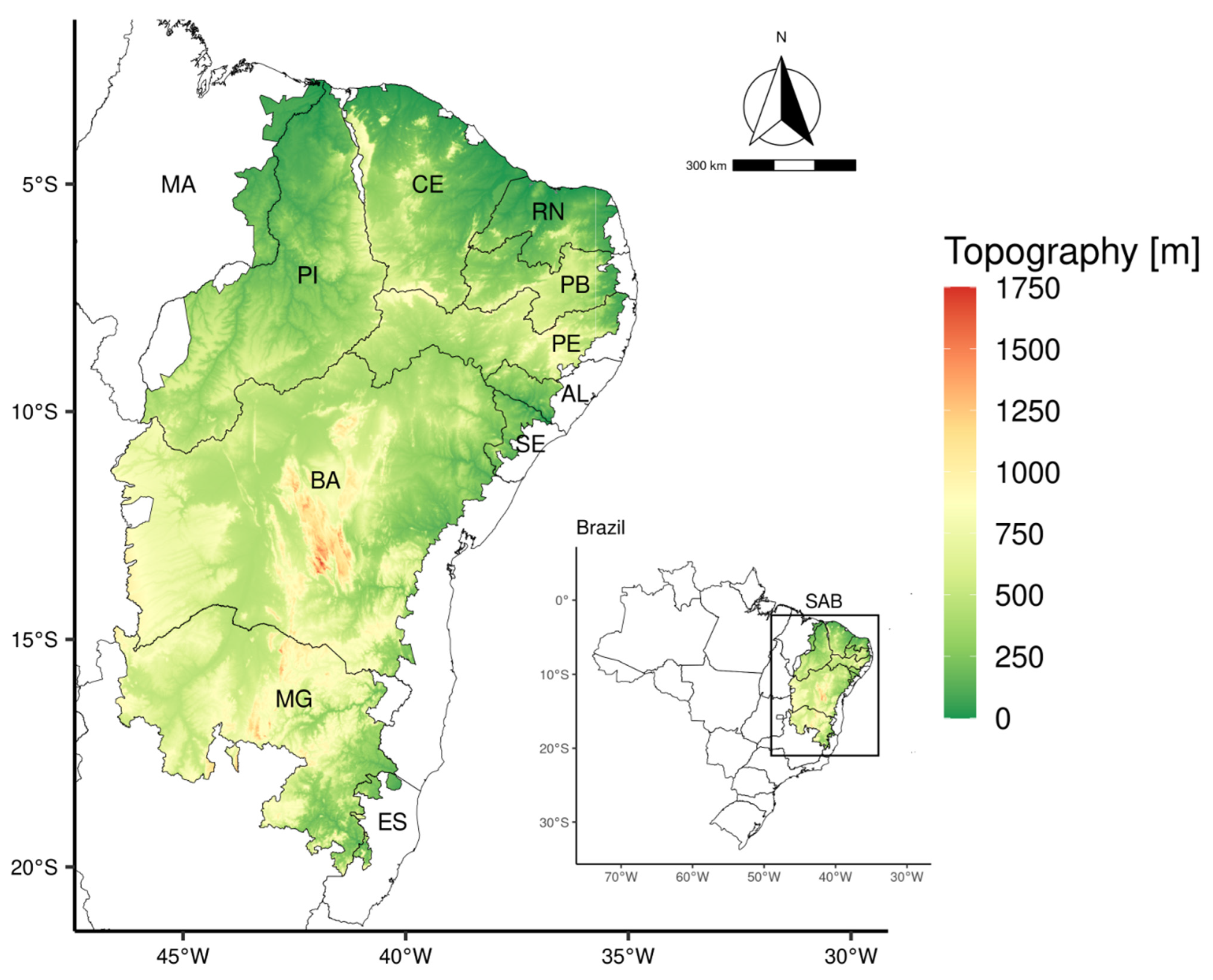
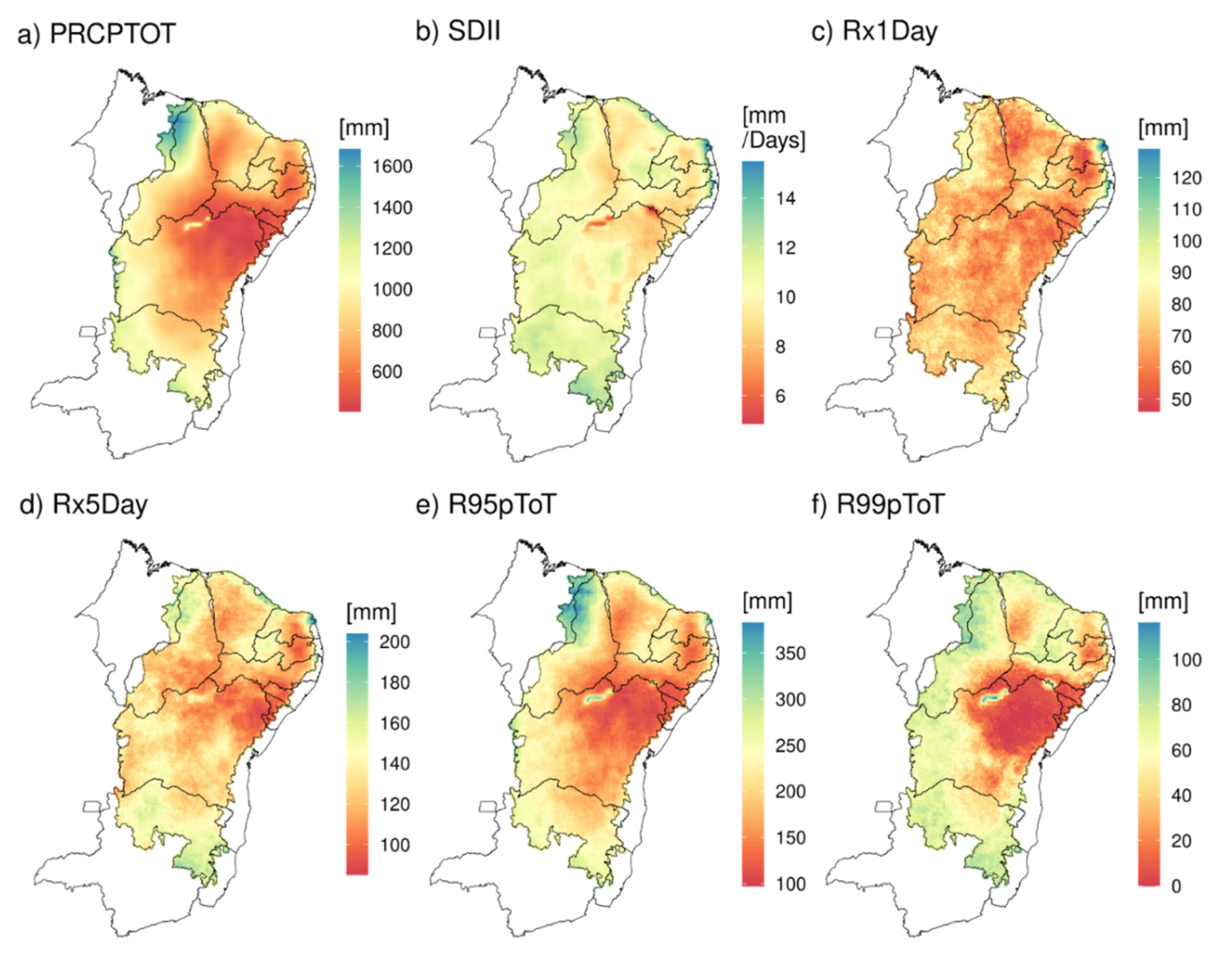
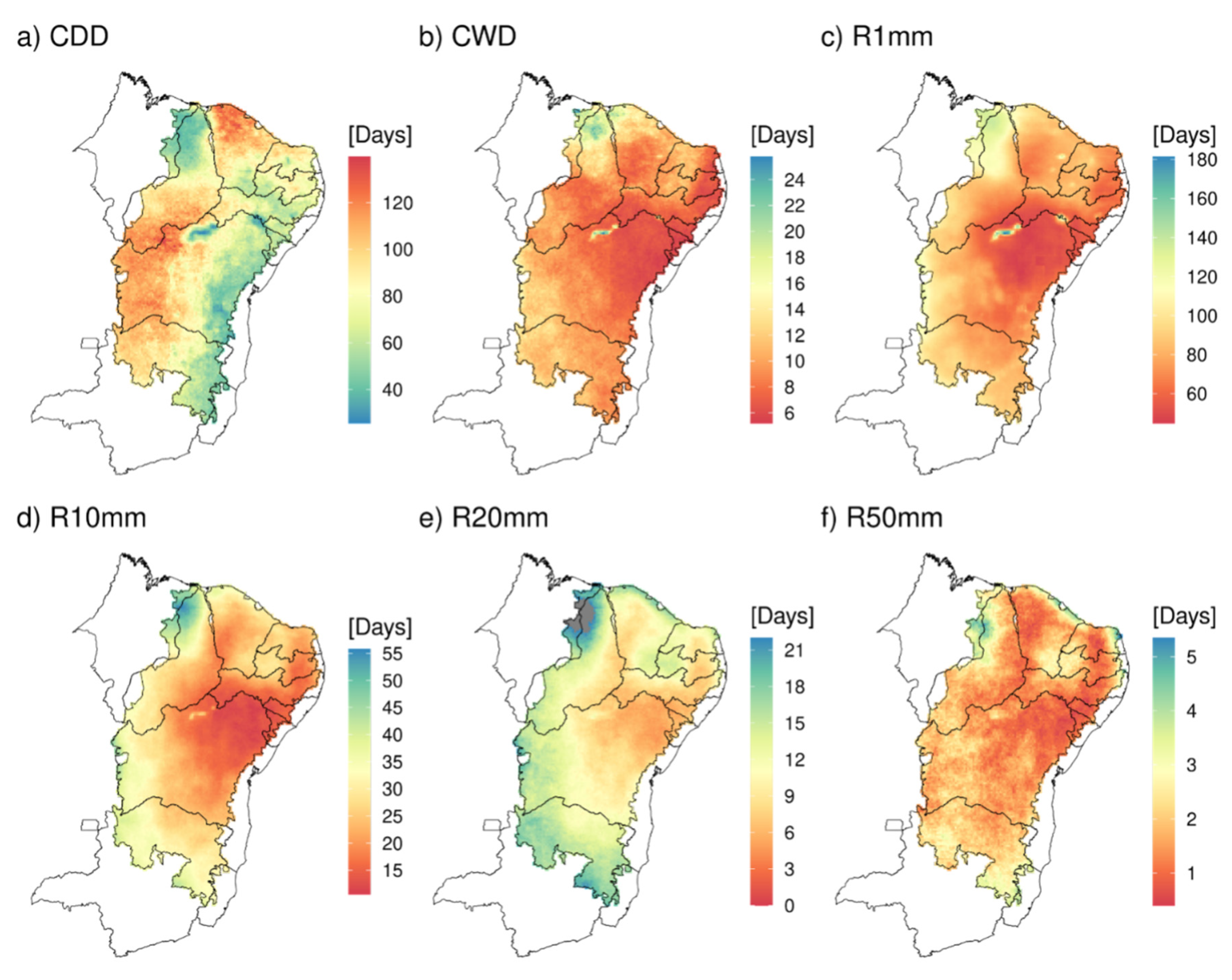
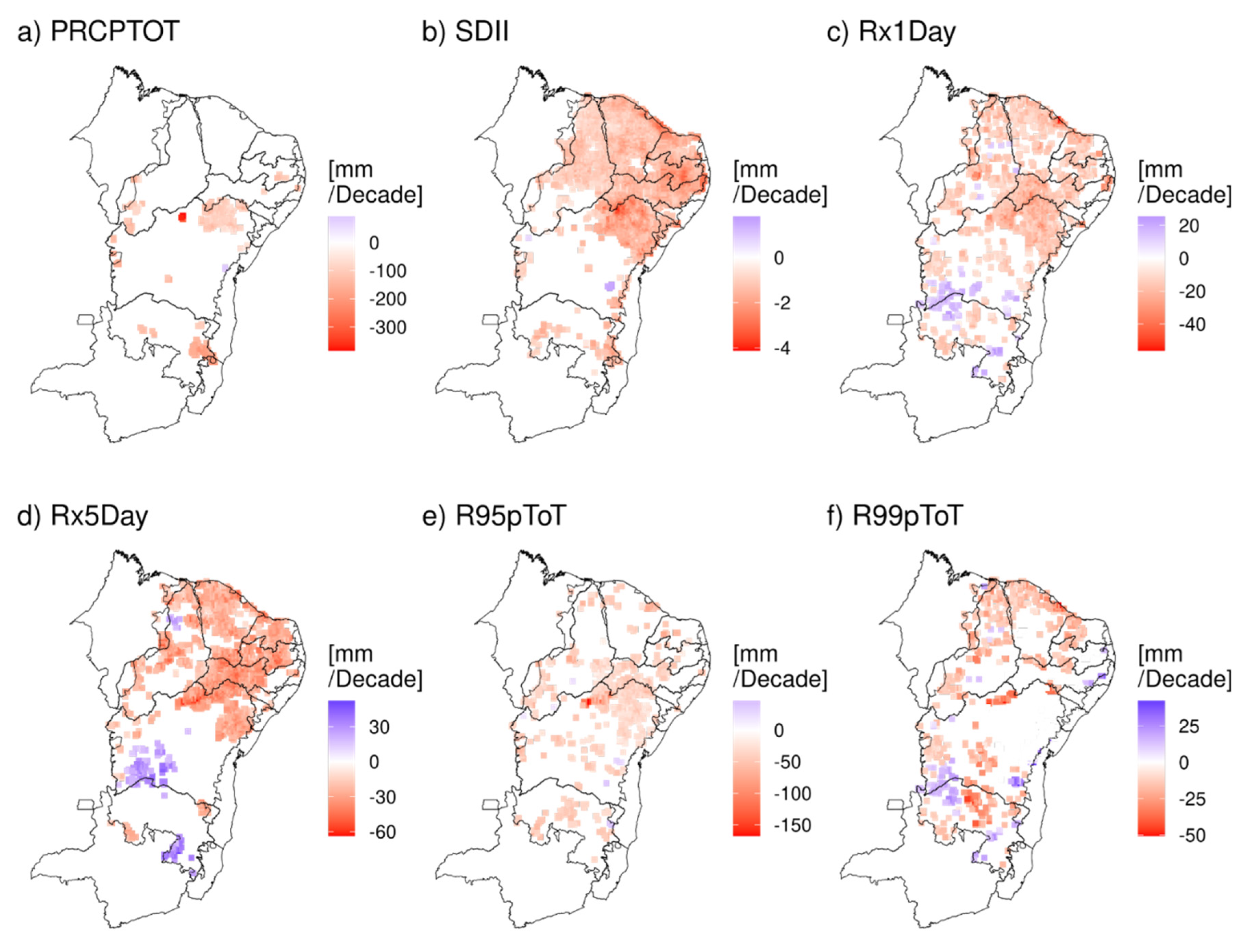
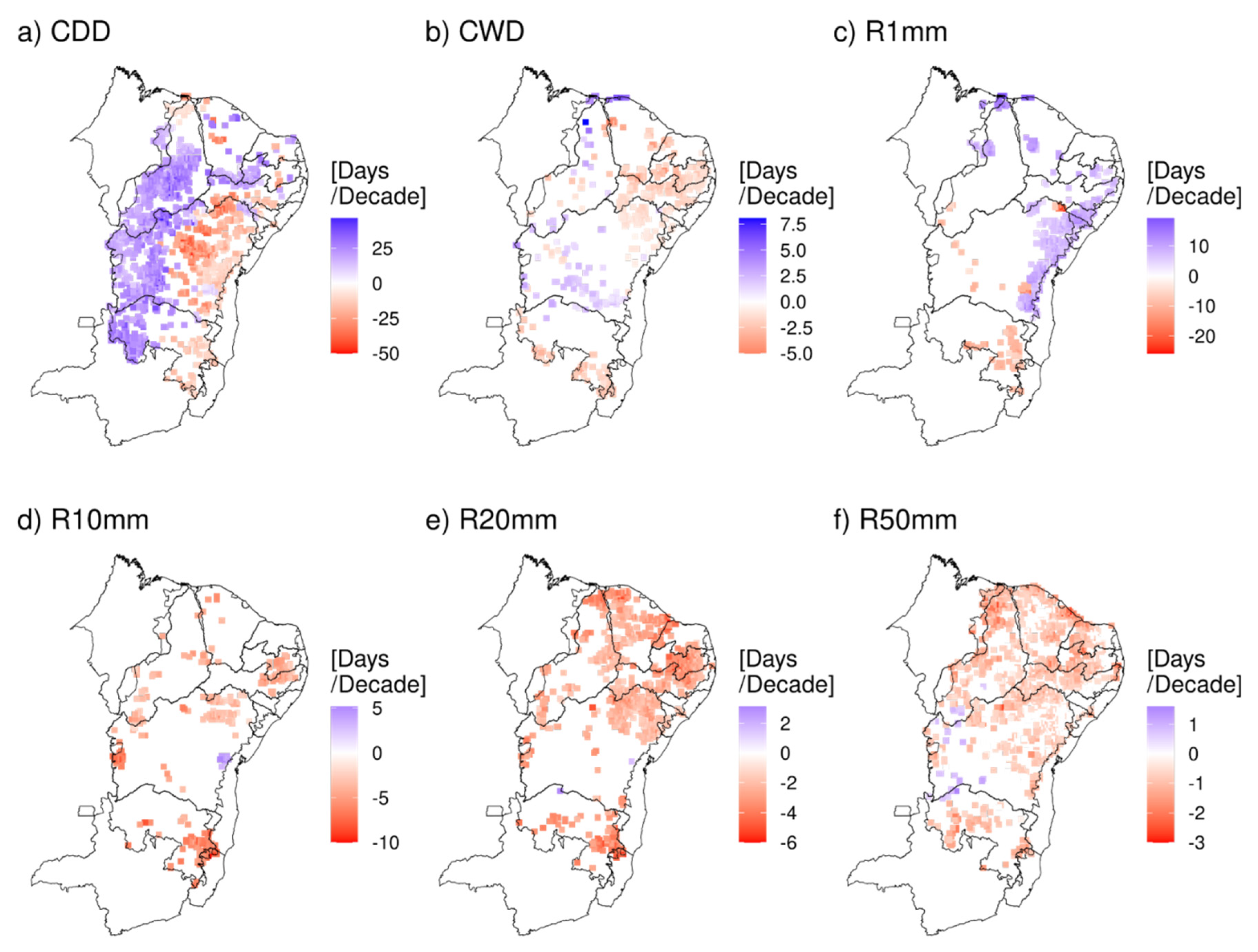
| Indices | Definitions | Units |
|---|---|---|
| PRCPTOT | Annual total precipitation on wet days | mm |
| SDII | Simple precipitation intensity index | mm/day |
| RX1day | Monthly maximum 1-day precipitation | mm |
| RX5day | Monthly maximum 5-day precipitation | mm |
| R95pToT | Annual total PRCP when RR > 95p | mm |
| R99pToT | Annual total PRCP when RR > 99p | mm |
| CDD | Maximum length of dry spell, maximum number of consecutive days with RR < 1 mm | days |
| CWD | Maximum length of wet spell, maximum number of consecutive days with RR ≥ 1 mm | days |
| R1 mm | Annual count of days when PRCP ≥ 1 mm | days |
| R10 mm | Annual count of days when PRCP ≥ 10 mm | days |
| R20 mm | Annual count of days when PRCP ≥ 20 mm | days |
| R50 mm | Annual count of days when PRCP ≥ 50 mm | days |
Disclaimer/Publisher’s Note: The statements, opinions and data contained in all publications are solely those of the individual author(s) and contributor(s) and not of MDPI and/or the editor(s). MDPI and/or the editor(s) disclaim responsibility for any injury to people or property resulting from any ideas, methods, instructions or products referred to in the content. |
© 2024 by the authors. Licensee MDPI, Basel, Switzerland. This article is an open access article distributed under the terms and conditions of the Creative Commons Attribution (CC BY) license (https://creativecommons.org/licenses/by/4.0/).
Share and Cite
dos Santos, A.L.M.; Gonçalves, W.A.; Andrade, L.d.M.B.; Rodrigues, D.T.; Batista, F.F.; Lima, G.C.; e Silva, C.M.S. Space–Time Characterization of Extreme Precipitation Indices for the Semiarid Region of Brazil. Climate 2024, 12, 43. https://doi.org/10.3390/cli12030043
dos Santos ALM, Gonçalves WA, Andrade LdMB, Rodrigues DT, Batista FF, Lima GC, e Silva CMS. Space–Time Characterization of Extreme Precipitation Indices for the Semiarid Region of Brazil. Climate. 2024; 12(3):43. https://doi.org/10.3390/cli12030043
Chicago/Turabian Styledos Santos, Ana Letícia Melo, Weber Andrade Gonçalves, Lara de Melo Barbosa Andrade, Daniele Tôrres Rodrigues, Flávia Ferreira Batista, Gizelly Cardoso Lima, and Cláudio Moisés Santos e Silva. 2024. "Space–Time Characterization of Extreme Precipitation Indices for the Semiarid Region of Brazil" Climate 12, no. 3: 43. https://doi.org/10.3390/cli12030043
APA Styledos Santos, A. L. M., Gonçalves, W. A., Andrade, L. d. M. B., Rodrigues, D. T., Batista, F. F., Lima, G. C., & e Silva, C. M. S. (2024). Space–Time Characterization of Extreme Precipitation Indices for the Semiarid Region of Brazil. Climate, 12(3), 43. https://doi.org/10.3390/cli12030043








